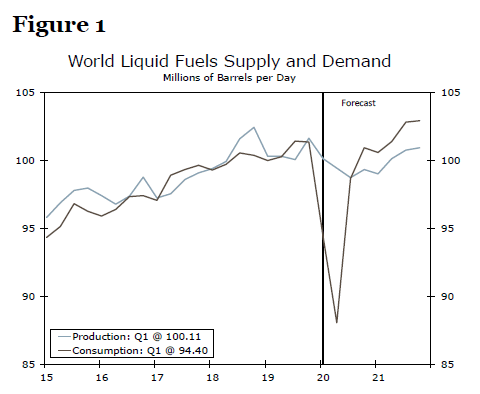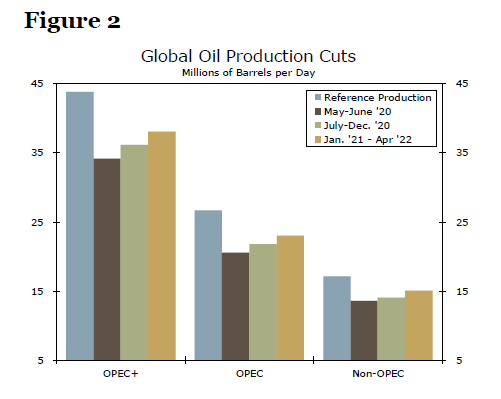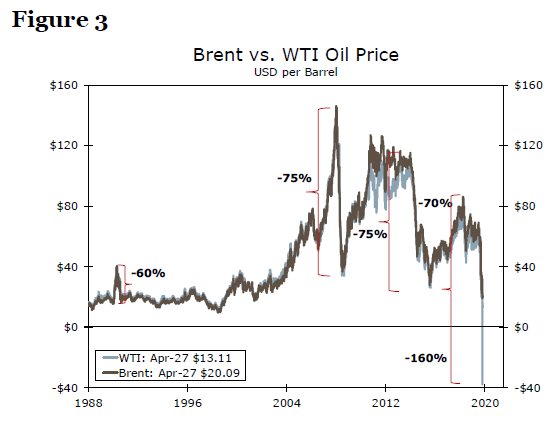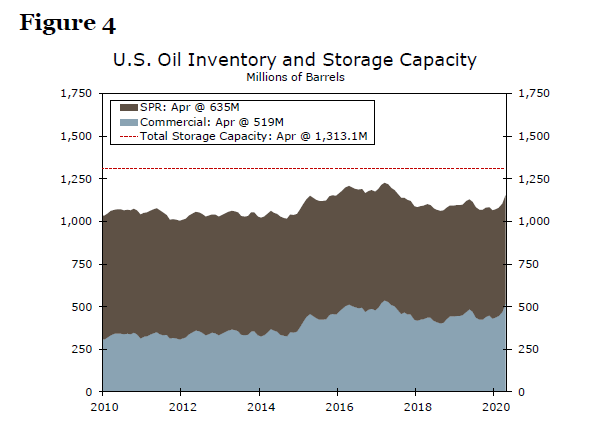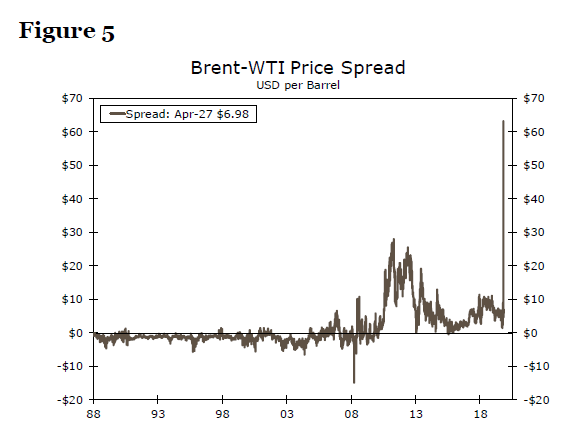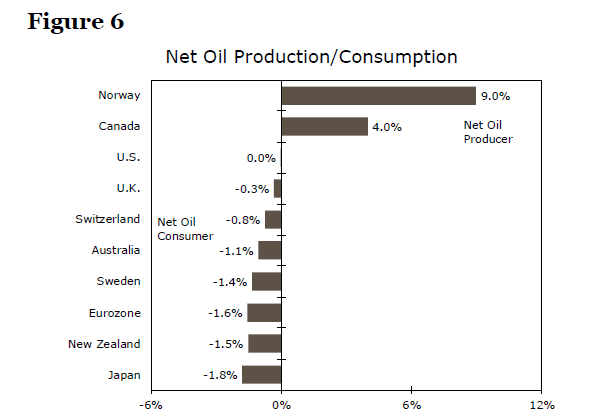Executive Summary
- Oil markets have come under extreme pressure this year amid the COVID-19 outbreak which has significantly reduced demand. In addition, the price war between Saudi Arabia and Russia earlier this year added to the supply glut. Although OPEC+ producers recently took action to cut production, the magnitude of cuts will likely not be sufficient to remove excess supply from the market.
- Since mid-April, the price of Brent crude is down over 70%, while the price of WTI is down over 80% and traded negative for the first time in history. The fall in WTI has been remarkable and has created unprecedented dynamics in oil markets. While WTI prices have returned to positive territory, storage capacity constraints in the United States should keep WTI prices restrained for now.
- Global oil prices are an important influence for our economic and currency forecasts, and as of now, the price of crude appears likely to stay near US$15-20/barrel in Q2, before rising gradually later this year. However, upside and downside scenarios do exist, with risks perhaps tilted toward a slower oil price recovery, or perhaps even further downside.
- Within the G10 space, Canada and Norway are most at risk from significantly lower oil prices. Both economies are likely to contract significantly, with risks tilted towards deeper annual GDP declines than we forecast. In addition, we expect downward pressure to build on their currencies, and currently expect Canadian dollar and Norwegian krone weakness through the end of Q3.
Oil Hit by Dual Shock
Over the course of the last few months, oil prices have come under significant pressure, with the sharp decline in crude contributing to already elevated volatility throughout financial markets. Without question, COVID-19 has been a major disrupter of oil markets. As governments around the world have implement social distancing measures and have locked down large portions of their economies, demand for oil has plummeted. Both international and domestic oil agencies have cut demand forecasts significantly, with the International Energy Agency (IEA) expecting global oil demand to fall by 9.3M barrels per day this year, while demand in April alone is forecast to be 29M barrels per day lower than the same time last year. In addition, the U.S. Energy Information Administration (EIA) forecast demand to fall by 5.2M barrels per day this year, while the April OPEC report indicates it expects global demand to decline by around 6.8M barrels per day. The shock to oil demand has created a massive oversupply in the global marketplace, which has placed downward pressure on prices.
The COVID-19 demand shock has not been the only headwind global oil markets have faced. Earlier this year, a price war between Saudi Arabia and Russia broke out as both nations failed to reach an agreement to extend existing production cuts. Saudi Arabia and Russia both rapidly lifted production to maximize output and regain market share. In the immediate aftermath, global oil prices, already under pressure from the effects of the virus, sold-off further given the prospect of further oversupply.
After a few weeks of maximum output from Saudi Arabia and Russia, OPEC members, Russia, and other top oil producers agreed to a production cut deal in an effort stabilize and/or lift global oil prices. However, the final production cut numbers were somewhat underwhelming and inadequate to stop the oil price decline. The final stipulations of the deal were for OPEC+ nations to cut production by a cumulative 9.7M barrels per day, about 10% of global output and the largest production cut agreement on record. Most OPEC+ nations plan to reduce output by 23% starting in May and lasting through the end of June, at which point cuts are set to taper off to 7.7M barrels per day in the second half of 2020, followed by 5.8M barrels per day from January 2021 through April 2022.
Looking ahead, OPEC+ nations should broadly comply with agreed upon production levels, though excess oil supply is very likely to persist. OPEC+ countries may consider additional production cuts, and indeed they have been in discussions regarding lowering output again. The next official OPEC+ meeting is scheduled for June 10, which provides an opportunity for further action and adjustments, although it is possible OPEC+ could even take action ahead of June in an unscheduled meeting and announcement.
Price Shock Intensifies, WTI Goes Negative
As a result of the multiple headwinds facing oil markets, global oil prices have collapsed. Since mid-April, Brent crude prices are down around 70%, while the price of WTI is down about 80%. The sell-off in oil prices during the COVID-19 pandemic is the worst peak-to-trough decline in prices the market has ever experienced. To put it into context, at the end of the oil price shock associated with the Gulf War in the early 1990s, Brent crude prices declined 56% and WTI fell close to 60%. Other oil price shocks occurred during the global financial crisis of 2008-2009 and in 2014-2016 when Brent and WTI each sold-off around 75%. Just this year, the peak-to-trough decline in Brent oil is 70%. However, WTI has declined 160%, as the benchmark for U.S. oil traded negative on April 20, closing at -$37.63 per barrel that day.
While developments at the global level certainly impact WTI prices, specific issues within the United States as well as the technicalities around how oil funds work exacerbated WTI’s sell-off. One of the most important issues is a lack of storage capacity within the United States. Given the large supply glut, the available storage in the United States is diminishing. According to estimates from the EIA and Department of Energy, as of April, the U.S. will have 519M barrels of oil in inventory (excluding the government’s Strategic Petroleum Reserve), while capacity is estimated to be 600M barrels. This means the United States has utilized 87% of its commercial storage capacity, up from 74% at the beginning of 2019.
Aside from commercial crude storage facilities, the United States also maintains the Strategic Petroleum Reserve (SPR), an underground crude storage facility that stretches across the Gulf of Mexico. The SPR is an emergency supply of oil that can be used to mitigate disruptions in supply and to carry out the United States’ obligations under the international energy program. It is the world’s largest supply of emergency crude oil and can only be utilized at the discretion of the U.S. president. Amid the current oversupply, President Trump has suggested he may opt to purchase 75M barrels of oil for the SPR in an effort to lessen excess oil supply. While in theory purchasing oil for the SPR is a good idea to try and rebalance markets, the SPR is also running out of capacity. As of April, the SPR held 635M barrels of oil while the Department of Energy indicates it has capacity for about 714M barrels. This means the SPR is 89% full and actually has less storage capability than commercial oil facilities at this time. Should President Trump move forward with purchasing 75M barrels of oil, the purchase would essentially use up all of the remaining storage capacity in the SPR.
Summing commercial and SPR storage capability, as of April the United States has utilized 88% of its total crude oil storage capacity. If President Trump implements his proposed oil purchases, 94% of the country’s oil storage capacity would be filled. In either scenario, the United States’ ability to rebalance the current supply and demand dynamics of the oil market is limited.
The issue of storage capacity limitations in the U.S. played a significant role in WTI’s sell-off into negative territory. Oil is traded on futures contracts, with final purchasers required to take physical delivery of oil when the contract is set to expire. It is possible, and historically been rather common, for oil investment funds and purchasers to roll over their monthly contracts shortly before their contract expires in the event an investment fund does not want to exit a position or a buyer does not want to take delivery just yet. Contracts for May delivery of WTI were set to expire on April 21, which put pressure on purchasers whose contracts were coming due Given limited storage capacity, many buyers of May WTI contracts opted to not take delivery or roll forward their contracts, and instead sold their contracts. As a result, WTI prices fell significantly, with prices going into negative territory, which effectively meant buyers of May futures contracts felt it made more financial sense to pay someone to take delivery of oil, rather than take delivery themselves.
The precipitous drop in WTI was remarkable and was the first time in history WTI traded in negative territory. The spread between Brent and WTI prices also widened to levels never before seen. While WTI has moved back into positive territory and the spread has normalized, the current oversupply make a sustained push higher seem unlikely in the near-term.
The Potential Outlook for Oil
As social distancing and lockdown measures are likely to remain in place for the near-term, oil demand should remain subdued and the significant oversupply of oil should persist for at least the next few months. Despite an agreement from OPEC+ members to cut production, and even if there were additional production cuts, it is likely there would need to be a pickup in demand to bring the market into balance. In this scenario, we believe oil prices will stay near current levels for some time, influencing our economic growth and inflation forecasts. Our assumptions behind this price forecast include:
- Lockdown measures in differing degrees in place for the next three months, which continues to limit oil demand.
- OPEC+ nations broadly comply with agreed upon production cuts and, potentially, reduce output further.
- Storage capacity remains limited, likely a restraining factor for oil futures prices for now.
- Brent crude target: US$18.00/barrel in Q2; gradual increase in H2 2020.
- WTI crude target: US$15.00/barrel in Q2; gradual increase in H2 2020.
Downside & Upside Risks Exist
We believe risks may be tilted towards a slower-than-expected recovery in oil prices, and perhaps even further oil price declines. For example, it is possible that COVID-19 continues to spread and lockdown measures are extended for another six to nine months, which would significantly reduce demand for oil. In addition, if OPEC+ countries were not substantially compliant with agreed upon production cuts, it could lead to renewed tensions between Saudi Arabia and Russia. In this scenario, global oil prices could be much weaker than expected.
There is also a scenario where oil prices rebound faster than expected. Upside risks would also be centered on the evolution of the virus. For example, the containment of COVID-19 could be quicker than expected with global lockdown measures removed earlier, OPEC+ countries could be more compliant with agreed production cuts, and President Trump could follow through with oil purchases for the SPR, helping to reduce excess oil supply. If these developments were to occur, a faster rebound in both Brent and WTI crude prices would be likely.
Norway and Canada Most at Risk in the G10
Given the likelihood of subdued oil prices in the near-term, we believe Canada and Norway are most at risk of an even sharper recession and annual GDP decline. Last week, Canadian oil prices declined significantly, with prices associated with certain Alberta oil types also trading in negative territory. Given the relevance of oil to the Canadian economy and how correlated Canadian asset prices are with oil, we believe the Canadian economy is entering a deep recession, which it may struggle to recover from as quickly as other G10 countries. As of now, we forecast the Canadian economy to contract 5.7% for full-year 2020 and for the Canadian dollar to weaken, and also note risks around these forecasts are tilted towards a weaker economy and Canadian currency. Low oil prices will likely permeate throughout Canada’s economy, weighing on local industry as well as the labor market. Should a more negative scenario materialize, we would re-evaluate our Canada GDP outlook and also potentially forecast more weakness in the Canadian dollar.
Norway is another economy which is highly dependent on oil, and we feel it is particularly vulnerable given the restrained outlook for global oil prices. Norway is a major oil producer, producing close to two million barrels of oil per day, however, it was not included in the OPEC+ production deal. Despite being excluded, Norway’s petroleum and energy minister indicated that the country is considering restraining its crude oil output in any case and looking at what additional measures it can take to help support oil prices. Historically, Norway has cut oil production several times, including in the 1990s and early 2000s as prices fell. That said, even if Norway were to cut production it may not have a significant impact on global oil prices. We currently forecast Norway’s economy to also fall into recession and contract 3% on a full-year basis in 2020 and forecast further weakness in the Norwegian krone. The krone is the weakest G10 currency this year, selling-off around 17% versus the greenback. We look for the krone to weaken in the near-term against the euro and greenback, but see an eventual stabilization as downside risks from both shocks lessen over the longer term.
Finally, we think the current low oil price environment will likely keep G10 central banks biased towards further monetary easing. As of now, the European Central Bank, Sweden’s central bank and Norway’s central bank are among those we expect to ease policy further. In terms of assessing the implications of low oil prices, central banks often balance the positive effects of increased purchasing power and thus growth from low prices, versus disinflationary or deflationary concerns. In the current environment, we expect that central banks will place limited weight on the positive impact on purchasing power. Given slumping consumer confidence it’s not clear that consumers would be willing to spend, nor is it clear how much of a purchasing power boost low oil prices would have given travel by autos and airplanes has been cut back dramatically. Instead, we expect G10 central banks to be more focused on the disinflationary impact of low oil prices, which should see most of those central banks maintain a bias toward policy easing over the weeks and months ahead.




